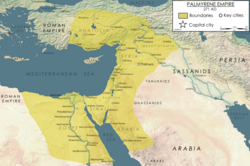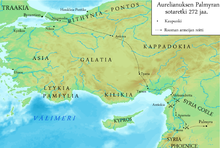Palmyrene Empire
Palmyrene Empire | |||||||||
|---|---|---|---|---|---|---|---|---|---|
| 260 (as kingdom)[1]/270 (as empire)–273 | |||||||||
 The Palmyrene Empire in 271 | |||||||||
| Capital | Palmyra | ||||||||
| Largest city | Alexandria[note 1] | ||||||||
| Common languages |
| ||||||||
| Government | Monarchy | ||||||||
| Monarch | |||||||||
• 267/270–272 | Vaballathus | ||||||||
• 272–273 | Zenobia | ||||||||
• 273 | Antiochus | ||||||||
| Historical era | Late Antiquity | ||||||||
• Established | 260 (as kingdom)[1]/270 (as empire) | ||||||||
• Disestablished | 273 | ||||||||
| |||||||||
The Palmyrene Empire was a short-lived
The Palmyrene Empire was ruled by Queen Zenobia, officially as regent for her son Vaballathus, who inherited the throne in 267 at age ten. In 270, Zenobia rapidly conquered most of the Roman east, attempting to maintain relations with Rome as a legitimate power. In 271, she claimed the imperial title for both herself and her son, fighting a short war with the Roman emperor Aurelian, who conquered Palmyra and captured Zenobia. A year later the Palmyrenes rebelled, which led Aurelian to raze Palmyra.
Despite its brief existence, the Palmyrene Empire is remembered for having been ruled by one of the most ambitious and powerful women in antiquity. It is also hailed in Syria, where it plays an important role as an icon in Syrian nationalism.
Background
Following the murder of Roman emperor
The Palmyrene leader
Odaenathus was succeeded by his minor son, the ten-year-old Vaballathus,[27] under the regency of Zenobia.[27][28] Vaballathus was kept in the shadow while his mother assumed actual rule and consolidated her power.[27] The queen was careful not to provoke Rome and took for herself and her son the titles that her husband had, while working on guaranteeing the safety of the borders with Persia, and pacifying the dangerous Tanukhid tribes in Hauran.[27]
Establishment

Zenobia started an expedition against the Tanukhids in the spring of 270, during the reign of emperor Claudius Gothicus[29] aided by her generals, Septimius Zabbai (a general of the army) and Septimius Zabdas (the chief general of the army).[30]
Zabdas sacked
In October of 270,
The Palmyrene conquests were done under the protective show of subordination to Rome.[44] Zenobia issued coinage in the name of Claudius' successor Aurelian with Vaballathus depicted as king,[note 4] while the emperor allowed the Palmyrene coinage and conferred the Palmyrene royal titles.[45] However, toward the end of 271, Vaballathus took the title of Augustus along with his mother.[44]
Reconquest by Rome



In 272, Aurelian crossed the
Entering
Aftermath

Aurelian spared the city and stationed a garrison of 600 archers led by a certain Sandarion, as a peacekeeping force.[62] The defenses were destroyed and most of the military equipment was confiscated.[63] Zenobia and her council were taken to Emesa and put on trial. Most of the high-ranking Palmyrene officials were executed,[64] while Zenobia's and Vaballathus's fates are uncertain.[65]
In 273, Palmyra rebelled under the leadership of a citizen named Septimius Apsaios,[66] and contacted the Roman prefect of Mesopotamia, Marcellinus, offering to help him usurp the imperial power.[66] Marcellinus delayed the negotiations and sent word to the Roman emperor,[66] while the rebels lost their patience and declared a relative of Zenobia named Antiochus as Augustus.[67] Aurelian marched against Palmyra and was helped by a Palmyrene faction from inside the city, headed by a man with a senatorial rank named Septimius Haddudan.[68][69]
Aurelian spared Antiochus,[69] but razed Palmyra.[70] The most valuable monuments were taken by the emperor to decorate his Temple of Sol,[61] while buildings were smashed, people were clubbed and cudgeled and Palmyra's holiest temple pillaged.[61]
Evaluation and legacy
The ultimate motive behind the revolt is debated; when dealing with the rise of Palmyra and the rebellion of Zenobia, historians most often interpreted the ascendancy as an indication of cultural, ethnic or social factors.
During the mid-twentieth century, interest in the Palmyrene Empire was briefly revived by the advent of Syrian nationalism.[78] Modern Syrian nationalists viewed the empire as a uniquely Syrian civilization which attempted to liberate the masses of the Levant from Roman tyranny.[79] A Syrian TV show was produced based on Zenobia's life, and she was the subject of a biography written by Syria's former minister of defense Mustafa Tlass.[79]
See also
Notes
- ^ Alexandria was the second largest city in the Roman Empire (after Rome itself),[2] with a population of around 500,000–600,000, during the principate.[3] The population of Palmyra in the middle of the 3rd century is estimated to have been 150,000–200,000.[4]
- ^ No evidence exists for Roman units serving in the ranks of Odaenathus; whether Roman soldiers fought under Odaenathus or not is a matter of speculation.[14]
- ^ The first decisive evidence for the use of this title for Odaenathus is an inscription dated to 271, posthumously describing Odaenathus as king of kings.[11][19] Odaenathus' son Hairan I is directly attested as "King of Kings" during his lifetime. Hairan I was proclaimed by his father as co-ruler; it is unlikely that Odaenathus was simply a king while his son held the King of Kings title.[20]
- ^ Claudius died in August 270, shortly before Zenobia's invasion of Egypt.[37]
- ^ All other accounts indicate that a military action was not necessary, as it seems that Zenobia had withdrawn her forces in order to defend Syria.[47]
- ^ Daphne was a garden located six miles south of Antioch.[53]
References
- ISBN 978-1-57958-316-3.
- ISBN 9783110812657.
- JSTOR 284172.
- ^ "Rise and fall of Palmyra, Syria". Bulletin of the Department of Geography of University of Tokyo. 27: 9. 1995.
- ^ ISBN 978-0-19-964667-8.
- ^ Averil Cameron (1993). The Later Roman Empire, AD 284-430. Harvard University Press. p. 3.
- ^ Averil Cameron (1993). The Later Roman Empire, AD 284-430. Harvard University Press. p. 4.
- ISBN 9781135955069.
- ^ Patrick J. Geary (2003). The Myth of Nations: The Medieval Origins of Europe. Princeton University Press. p. 81.
- ISBN 9781846031984.
- ^ ISBN 978-0-19-986110-1.
- ^ ISBN 9781579583163.
- ISBN 9780521849258.
- ISBN 978-1-4411-7351-5.
- ISBN 9780809592357.
- ISBN 9780748620500.
- ISBN 9004045082.
- ISBN 9781107012059.
- ISBN 0472083155.
- ISBN 9781441142481.
- ISBN 9780674016835.
- ^ ISBN 9781847250346.
- ISBN 978-0-19-100292-2.
- ISBN 0472083155.
- ^ Edward Gibbon; Thomas Bowdler (1826). History of the decline and fall of the Roman empire for the use of families and young persons: reprinted from the original text, with the careful omission of all passagers of an irreligious tendency, Volume 1. p. 321.
- ISBN 9780815550365.
- ^ ISBN 978-0-19-964667-8.
- ISBN 0472083155.
- ^ ISBN 978-0-19-100293-9.
- ISBN 978-0-19-986110-1.
- ISBN 9781134908158.
- ISBN 9789960000114.
- ISBN 9780674778863.
- ISBN 978-9004184275.
- ISBN 9781780765648.
- ISBN 978-0-19-964667-8.
- ^ ISBN 9781134908158.
- ISBN 9781441142481.
- ISBN 978-0-19-100293-9.
- ISBN 978-0-19-964667-8.
- ISBN 9781134908158.
- ^ ISBN 9781134908158.
- ^ ISBN 9781134823871.
- ^ ISBN 978-0-19-986110-1.
- ISBN 9781579583163.
- ISBN 978-0-19-964667-8.
- ^ ISBN 978-0-19-964667-8.
- ISBN 9781134908158.
- ^ ISBN 9781134908158.
- ISBN 0472083155.
- ISBN 978-0-19-964667-8.
- ISBN 9781134908158.
- ^ John Carne; William Purser (1836). Syria, the Holy Land, Asia Minor, &c. illustrated: In a series of views drawn from nature. Fisher, Son, & Co.; London, Paris, & America. p. 31.
- ISBN 9781441142481.
- ISBN 9781134908158.
- ISBN 978-0-19-964667-8.
- ISBN 9781134908158.
- ^ ISBN 9780521301992.
- ISBN 0472083155.
- ^ ISBN 9781134908158.
- ^ ISBN 9781134823871.
- ISBN 978-0-19-964667-8.
- ISBN 9781134908158.
- ^ William Ware (1846). Zenobia, Or, The Fall of Palmyra: A Historical Romance in Letters from L. Manlius Piso from Palmyra, to His Friend Marcus Curtius at Rome. p. 242.
- ISBN 9781134823864.
- ^ ISBN 978-0-19-986110-1.
- ISBN 978-0-19-986110-1.
- ISBN 9780892367153.
- ^ ISBN 9781134908158.
- ISBN 9780521301992.
- ^ a b c d Nakamura 1993, p. 133.
- ^ Hitti 2002, p. 73.
- ^ Zahrān 2003, p. 36.
- ^ a b Whittow 2010, p. 154.
- ^ a b Ball 2002, p. 82.
- ^ a b c Smith II 2013, p. 180.
- ^ Millar 1993, p. 334.
- ISBN 9781444183887.
- ^ ISBN 978-0-19-025737-8.
Bibliography
- Nakamura, Byron (1993). "Palmyra and the Roman East". Greek, Roman, and Byzantine Studies. 34. Duke University, Department of Classical Studies. ISSN 0017-3916.
- Hitti, Philip K. (2002) [1937]. History of The Arabs (10 ed.). Palgrave Macmillan. ISBN 978-1-137-13032-7.
- Zahrān, Yāsamīn (2003). Zenobia between reality and legend. BAR (British Archaeological Reports) International Series. Vol. 1169. Archaeopress. ISBN 978-1-84171-537-7.
- ISBN 978-0-521-83823-8.
- Ball, Warwick (2002). Rome in the East: The Transformation of an Empire. Routledge. ISBN 978-1-134-82387-1.
- Smith II, Andrew M. (2013). Roman Palmyra: Identity, Community, and State Formation. Oxford University Press. ISBN 978-0-19-986110-1.
- Millar, Fergus (1993). The Roman Near East, 31 B.C.-A.D. 337. Harvard University Press. ISBN 978-0-674-77886-3.
